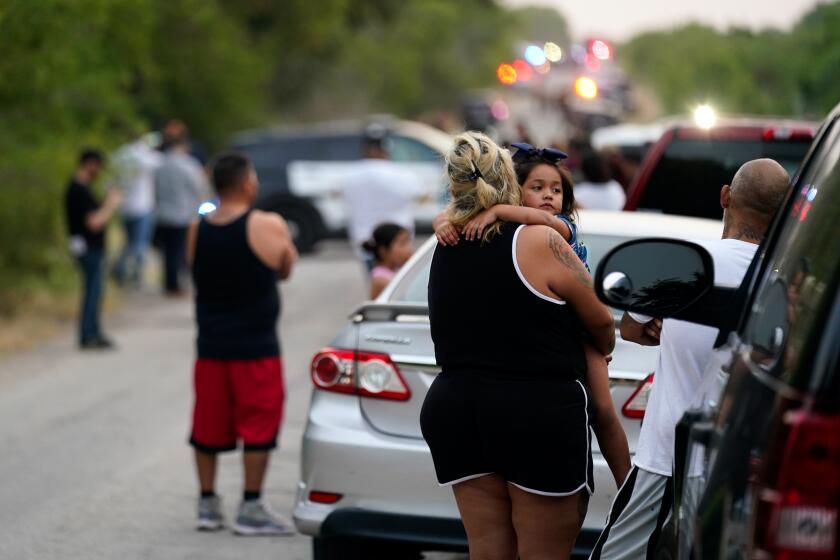Op-Ed: U.S. border killings evade justice. An international commission can change that

To people of color in the United States, the death of Anastasio Hernández-Rojas — a brutal killing at the hands of U.S. government officials followed by impunity — is all too familiar. Yet in an extraordinary moment challenging that impunity, the Inter-American Commission on Human Rights convened a hearing this month to consider testimony about his treatment by Customs and Border Protection agents.
By requiring the United States to appear and defend its policies, the commission’s review of this case offers a unique opportunity: a legal finding by an independent international body that “use of force” policies in the U.S. are contrary to its obligations under international law, not to mention basic human rights.
On May 28, 2010, Hernández-Rojas — an undocumented Mexican national and father of five — attempted to cross from Mexico into the U.S. at the border near San Diego. He was detained by border patrol agents. He was then violently abused, according to detailed allegations presented to the Inter-American Commission.
The Border Patrol needs reform. Too bad the man with the experience to do it got pushed out by the Biden administration.
Hernández-Rojas was punched, kicked, dragged, Tasered and denied medical treatment by officers. Witnesses reported that he did not attempt to harm the officers. On recordings, he is heard screaming in pain and begging for mercy. As a result of this brutal assault, Hernández-Rojas suffered severe physical injuries, brain damage and eventual cardiac arrest. He died three days after being taken into custody. The San Diego medical examiner’s office ruled the death a homicide.
No criminal charges were ever filed in this case. In fact, the Justice Department declined to bring charges against the CBP officers involved on the grounds that their actions complied with established use of force policies. A lawsuit filed by Hernández-Rojas’ family against the United States government resulted in a $1-million settlement, but no admission of fault by U.S. officials.
For decades, the same cycle — kill, pay and deny responsibility — has continued. Since 2010, there have been nearly 250 fatal encounters between migrants and CBP agents. Despite these deaths, few CBP officers have been prosecuted. There have been no known convictions of agents for border killings.
This dynamic is not unique to migrants at the U.S. border; law enforcement officials across the country have dodged accountability for using excessive force against people of color. But the Hernández-Rojas case — the first case taken by the Inter-American Commission that involves an extrajudicial killing at the hands of U.S. law enforcement — could challenge that norm.
In use of force cases, law enforcement officers can only be found criminally liable for willful misconduct, and only when their actions are determined to be objectively unreasonable. These exceedingly high standards, upheld by the Supreme Court, are tough for prosecutors to prove. They frame evaluations of the use of force entirely from the perspective of the officer and their subjective perception of danger. The end result privileges officers over victims and makes it easier for the government to sidestep responsibility.
Thousands of desperate migrants have died trying to cross the militarized U.S. border, but U.S. administrations refuse to change border strategies that drive these deaths.
In their presentations to the Inter-American Commission, however, Hernández-Rojas’ attorneys — led by the UC Berkeley International Human Rights Law Clinic and Alliance San Diego — argued convincingly that use of force cases should be reframed. Rather than focusing on the officer’s perspective, use of force should be assessed through the guiding principle of international human rights law — the state obligation to respect and protect the right to life.
This approach would impose a higher standard to justify the use of force and would respect international norms that the U.S. has accepted, including the American Declaration of the Rights and Duties of Man, which was violated when Hernández-Rojas was killed without cause or justification.
Given that the Justice Department already closed its investigation into this case, the government is unlikely to accept responsibility, and the Inter-American Commission ultimately lacks the authority to force it to do so. But there is still value in this case.
A ruling against the U.S. would publicly declare it out of compliance with human rights standards, highlight the shortcomings of its use of force policy and establish a precedent for future cases. The hearings have already accomplished a meaningful achievement: For the first time, Hernández-Rojas’ family appeared before a legal body and was allowed to explain how his death affected them. U.S. government officials were also forced to appear, listen to this powerful testimony and attempt to defend U.S. policy.
Although this case involves a single death at the U.S.-Mexico border, the commission can make a statement against the endless cycle of kill, pay and deny that characterizes justice at the border.
Migrants fleeing poverty and violence face many perils in their journey to the U.S. The threat should not increase when they are met by officials at the border. A ruling in favor of Hernández-Rojas’ family could achieve what the Supreme Court and the American legal system have failed to accomplish — reframing use of force law so that victims, not perpetrators, are placed in a position of privilege.
William J. Aceves is a law professor at California Western School of Law in San Diego. He filed a brief in support of Hernández-Rojas with the Inter-American Commission on Human Rights.
More to Read
A cure for the common opinion
Get thought-provoking perspectives with our weekly newsletter.
You may occasionally receive promotional content from the Los Angeles Times.












